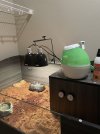You are using an out of date browser. It may not display this or other websites correctly.
You should upgrade or use an alternative browser.
You should upgrade or use an alternative browser.
My tortoise isn’t drinking water
- Thread starter PoptartTheTort
- Start date
Littleredfootbigredheart
Well-Known Member
Hello there! Poptart is SO cute!! How old is she?🥰
It might be you’re just missing the moments she’s getting a quick drink? Either way, as long as you’re doing daily soaks and your humidity is where it should be, coupled with the natural liquids in their diet, they should be adequately hydrated🙂and always have fresh water available👍
I don’t suppose you’d mind sharing some info on how you’re keeping them? It’s so good to know with new members, a photo of your full set up would be great!😊
What are your temperatures like?
Your humidity levels?
What kind of lighting/heating are you using?
Indoor uv? If so what kind?
Is that coco coir substrate?
How’s their diet been with you? I have a great list of stuff we personally feed ours if you’d like some ideas for variety! I’m always on the look out for additions, so feel free to share yours😁
It might be you’re just missing the moments she’s getting a quick drink? Either way, as long as you’re doing daily soaks and your humidity is where it should be, coupled with the natural liquids in their diet, they should be adequately hydrated🙂and always have fresh water available👍
I don’t suppose you’d mind sharing some info on how you’re keeping them? It’s so good to know with new members, a photo of your full set up would be great!😊
What are your temperatures like?
Your humidity levels?
What kind of lighting/heating are you using?
Indoor uv? If so what kind?
Is that coco coir substrate?
How’s their diet been with you? I have a great list of stuff we personally feed ours if you’d like some ideas for variety! I’m always on the look out for additions, so feel free to share yours😁
What kind of dish are you using? Post a pic of it. It should be a shallow clay saucer.
PoptartTheTort
New Member
That could be true. For your questions, my daytime temperatures in the enclosure are normally around 80 degrees Fahrenheit, nighttime is around 72-ish I’d say, as I do have a cherry head (basically a smaller red foot)Hello there! Poptart is SO cute!! How old is she?🥰
It might be you’re just missing the moments she’s getting a quick drink? Either way, as long as you’re doing daily soaks and your humidity is where it should be, coupled with the natural liquids in their diet, they should be adequately hydrated🙂and always have fresh water available👍
I don’t suppose you’d mind sharing some info on how you’re keeping them? It’s so good to know with new members, a photo of your full set up would be great!😊
What are your temperatures like?
Your humidity levels?
What kind of lighting/heating are you using?
Indoor uv? If so what kind?
Is that coco coir substrate?
How’s their diet been with you? I have a great list of stuff we personally feed ours if you’d like some ideas for variety! I’m always on the look out for additions, so feel free to share yours😁
For humidity levels, they are around 80 all the time, and I use a humidifier, as all my mist sprayers I buy for some reason just break. If I wanted to spray the enclosure, I just use my spray bottle and fill it with water.
For heating and lighting, I use Fluker’s 100 watt basking bulb, along with the light on my ceiling.
I honestly forget what brand of UV light I use, I got it at PetSmart I’m pretty sure.
It’s coconut fiber substrate, I do use coco coir substrate a lot though, in the picture, it’s probably coco coir substrate. I feed her tomato, watermelon, lettuce, and sometimes some cabbage. However, just recently about a week ago, she started being much more picky, not even touching her cabbage or carrots. She doesn’t even eat much of her watermelon anymore, and she usually eats almost if not all of it. I do always make sure to sprinkle calcium on her food though.
By the way, I recently moved her into my big closet (It’s nothing to worry about, it’s basically a small version of my bedroom.) Thought I’d mention it here. Oh, and in the picture below, the spot where some objects are placed on top of is where her hide is. 🐢
Attachments
Not drinking for two reasons:
1. The daily soaks and food have the tortoise already well hydrated.
2. Wrong type of water dish. The sides are too tall. You need a large, shallow terra cotta saucer sunk into the substrate.
Other tips intended to be helpful. Please don't feel attacked or insulted. If no one tells you what is wrong, you can't fix it.
1. The enclosure is much too dry. The substrate need to be damp.
2. Humidifiers should not be blowing directly into a tortoise enclosure. Its not good for them to be breathing in those micro droplets. This is not the same thing as humidity. Maintain high humidity by using a large closed chamber.
Open tops can't work. Its just physics. That is like trying to heat your house in winter with no roof on it. You need to contain the warm humid air inside the enclosure.
3. 72 at night is much too cool for this species. It should be 82-86 24/7.
4. That diet is slowly killing this tortoise. You need to improve it immediately.
5. Coco fiber substrate is dangerous and should not be used for a tortoise. Coco coir, aka: coco peat, is safe, but its hard to use that with a RF and not get shell rot. Orchid bark works better.
6. Wrong bulbs.
Sorry to give you so much bad news. It is obvious that you have tried to make a great environment, but unfortunately, you found the wrong care advice.
Here is a RF care sheet that works:
 tortoiseforum.org
tortoiseforum.org
More general info here:
 tortoiseforum.org
tortoiseforum.org
Questions are welcome.
1. The daily soaks and food have the tortoise already well hydrated.
2. Wrong type of water dish. The sides are too tall. You need a large, shallow terra cotta saucer sunk into the substrate.
Other tips intended to be helpful. Please don't feel attacked or insulted. If no one tells you what is wrong, you can't fix it.
1. The enclosure is much too dry. The substrate need to be damp.
2. Humidifiers should not be blowing directly into a tortoise enclosure. Its not good for them to be breathing in those micro droplets. This is not the same thing as humidity. Maintain high humidity by using a large closed chamber.
Open tops can't work. Its just physics. That is like trying to heat your house in winter with no roof on it. You need to contain the warm humid air inside the enclosure.
3. 72 at night is much too cool for this species. It should be 82-86 24/7.
4. That diet is slowly killing this tortoise. You need to improve it immediately.
5. Coco fiber substrate is dangerous and should not be used for a tortoise. Coco coir, aka: coco peat, is safe, but its hard to use that with a RF and not get shell rot. Orchid bark works better.
6. Wrong bulbs.
Sorry to give you so much bad news. It is obvious that you have tried to make a great environment, but unfortunately, you found the wrong care advice.
Here is a RF care sheet that works:
Redfoot Tortoise Care Sheet
NOTE: I do not keep redfoots, and I only have one tortoise in total. With this in mind, remember that I am in no way an expert, and this should not be used as cold hard proof of how to raise a redfoot. I used information from great keepers on this forum to put everything together. This care...
More general info here:
Info For New People. Please Read This First.
Hello and welcome to tortoiseforum.org! We are all glad you are here! There is no other forum like this anywhere. We have tens of thousands of members from all over the world ranging from kids with their first tortoise to people who have been breeding and keeping high end tortoises since the...
Questions are welcome.
Littleredfootbigredheart
Well-Known Member
As Tom has said there are some changes that need to be made to help your baby thrive🥰
I’m going to include some information below that will hopefully help!
As adults they need a pretty large enclosure, roaming is vital to tortoise health, it aids digestion and strengthens their muscles. For an adult red foot, you’re looking at room sized. Outdoors is ideal but only if your climate is right for them.
Don’t think they can get away with smaller if allowed to free roam, I’d highly discourage indoor free roams.
I’m going to include some information below on an example of an appropriate indoor set up, it includes the correct levels and equipment, indoor uv etc
If using a light emitting heat source it should be an incandescent floodlight(example attached)on a 12 hour timer, using a CHE(ceramic heat emitter) for night heat.
However I think ceramics as a heat source are more suited to red foot’s and far less desiccating on their shells.
Red foot’s don’t necessarily need a ‘basking area’ they aren’t typically a basking species coming from the forest floor(some do though, it depends on the individual) there’s no need for a ‘cooler end’ and ‘warmer end’ with these guys, aim for an overall ambient temperature range of 80-86(82-84 being optimal)temps shouldn’t be going below 80 for both night&day.
Personally we rely on CHE’s(ceramic heat emitters) as our heat source 24/7, on thermostats, they’re a non light emitting bulb and I think you’ll find it easier switching to these as your heat source to keep your temps nice and stable. When using multiple hang them equal distance to distribute the heat more evenly.
Dome fittings will help project the heat down, but don’t rely on the clamps that come with them, always hang them securely.
You can then hang some ambient lighting on a 12hour timer, it can being either a led strip or a led bulb in 5000k-65000k colour range. Create lots of shady areas with safe plants and hides, red foots don’t like things too bright.
Any indoor UV needs to be provided as a t5 tube fluorescent light, the compact or all in one bulbs either are too harsh creating uv hot spots that can damage their eyes, or are far too weak. I’ve attached the brands to go for and examples of stands to mount them. I’d personally recommend the Arcadia as it comes with the reflector fitting.
However if you’re able to get them out for a few hours of natural sunlight daily, don’t worry about the uv. Just make sure it’s not too warm and they’re in a secure run with lots of shade.
Your red foot ideally needs around 80% humidity 24/7 to thrive, the right substrate and a good closed chamber set up goes a long way in making this work. You’ll constantly struggle with an open top like that.
We personally keep our red foot on orchid bark, we focus on the under layer of the substrate being nice and damp to create the humidity, then the top layer being dry, the trouble with constantly spraying is, one, it can only lasts so long, and two, keeping that top layer constantly damp will leave them more prone to a fungal infection, avoid misters/foggers for this reason too, the humidifiers can also make the air too wet leading to respiratory issues. To stop that top layer getting a little too dry because you don’t want dusty substrate, we mix it now n then, which also helps gives a humidity boost without extra water🙂to maintain our humidity we simply pour some lukewarm water into the corners of the substrate, not loads! Just enough to dampen the whole under layer. You can keep an eye on your monitors&substrate to do the pours as and when needed, which in a good closed chamber set up, you shouldn’t have to do loads😊
Substrate wise never add any kind of moss, that’s something some stores think nothing of, but it can actually cause lethal impactions.
Don’t use any top soils or anything mixed with sand. Unless you’ve composted it yourself, there’s no way of knowing what kind of plants have gone into top soils, could be something toxic. Sand is an irritant. The coco fibres can be a risk too so I’d stick with the coir if you want to keep the ‘dirt’ route.
Safe substrate options are coco coir, damp and packed down by hand as a base, with orchid bark(fir not pine) on top, or forest floor on top, or just the orchid bark/ forest floor on their own.
Size wise I’d generally recommend you make your own base to go as big as you possibly can for the space you have, this tortoise full grown is going to need a large, secure space that meet their environmental needs. A good cost effective closed chamber set up would be a greenhouse style enclosure by making your own large base out of a safe material. Line with some cheap pond liner, the lining going up the sides too and make sure those sides are high enough. Then simply secure a greenhouse topper on top, if you can’t find an exact fit, place it over like the one with the white base in the photo, I’d place some lining under the cover and base though to avoid condensate getting on your floor.
Some people even hang their lighting and heat from the greenhouse frame! Simply wrap the wire around for the height you need(check with a temperature gun/add thermostats, roughly 18-21 inches for the uv) and secure with cable ties and chains. Or you could make your own stands out of safe timber, again I’ll attach some pics.
If you struggle finding a large enough greenhouse topper, you could maybe use some pvc covering to put over stands, or maybe looking into some sort of greenhouse polytunnel😊
For a water dish a large terracotta saucer, sitting flush with the substrate is safest, they have grip in the event the tortoise flips, most pet store options are a hazard like the one you’re using, it’s also not big enough for the tortoise to self soak if they want to.
Id definitely recommend a temp gun to make sure your monitors are reading correctly. Have monitors that read both temp and humidity.
Ignore whatever else is in the photos in the enclosures, they’re just to give you an idea😊and ignore that some of the fittings in the pics are floodlights, ches will work great, just examples on how to hang your bulbs👍
The examples are too small tbh, but my idea is something like that on a larger scale.
Also as this is a closed chamber set up, the materials like the lining and cover will need time to off gas, I’d leave it all running up to a week, or until there is no odour, if there’s no smell, it’s safe for use.
I’ll include a diet list of some stuff we feed ours in my next reply, to hopefully help give you some ideas for variety, you can squeeze some of the juice from the fruit onto their greens to entice them to eat it all🙂
I’m going to include some information below that will hopefully help!
As adults they need a pretty large enclosure, roaming is vital to tortoise health, it aids digestion and strengthens their muscles. For an adult red foot, you’re looking at room sized. Outdoors is ideal but only if your climate is right for them.
Don’t think they can get away with smaller if allowed to free roam, I’d highly discourage indoor free roams.
I’m going to include some information below on an example of an appropriate indoor set up, it includes the correct levels and equipment, indoor uv etc
If using a light emitting heat source it should be an incandescent floodlight(example attached)on a 12 hour timer, using a CHE(ceramic heat emitter) for night heat.
However I think ceramics as a heat source are more suited to red foot’s and far less desiccating on their shells.
Red foot’s don’t necessarily need a ‘basking area’ they aren’t typically a basking species coming from the forest floor(some do though, it depends on the individual) there’s no need for a ‘cooler end’ and ‘warmer end’ with these guys, aim for an overall ambient temperature range of 80-86(82-84 being optimal)temps shouldn’t be going below 80 for both night&day.
Personally we rely on CHE’s(ceramic heat emitters) as our heat source 24/7, on thermostats, they’re a non light emitting bulb and I think you’ll find it easier switching to these as your heat source to keep your temps nice and stable. When using multiple hang them equal distance to distribute the heat more evenly.
Dome fittings will help project the heat down, but don’t rely on the clamps that come with them, always hang them securely.
You can then hang some ambient lighting on a 12hour timer, it can being either a led strip or a led bulb in 5000k-65000k colour range. Create lots of shady areas with safe plants and hides, red foots don’t like things too bright.
Any indoor UV needs to be provided as a t5 tube fluorescent light, the compact or all in one bulbs either are too harsh creating uv hot spots that can damage their eyes, or are far too weak. I’ve attached the brands to go for and examples of stands to mount them. I’d personally recommend the Arcadia as it comes with the reflector fitting.
However if you’re able to get them out for a few hours of natural sunlight daily, don’t worry about the uv. Just make sure it’s not too warm and they’re in a secure run with lots of shade.
Your red foot ideally needs around 80% humidity 24/7 to thrive, the right substrate and a good closed chamber set up goes a long way in making this work. You’ll constantly struggle with an open top like that.
We personally keep our red foot on orchid bark, we focus on the under layer of the substrate being nice and damp to create the humidity, then the top layer being dry, the trouble with constantly spraying is, one, it can only lasts so long, and two, keeping that top layer constantly damp will leave them more prone to a fungal infection, avoid misters/foggers for this reason too, the humidifiers can also make the air too wet leading to respiratory issues. To stop that top layer getting a little too dry because you don’t want dusty substrate, we mix it now n then, which also helps gives a humidity boost without extra water🙂to maintain our humidity we simply pour some lukewarm water into the corners of the substrate, not loads! Just enough to dampen the whole under layer. You can keep an eye on your monitors&substrate to do the pours as and when needed, which in a good closed chamber set up, you shouldn’t have to do loads😊
Substrate wise never add any kind of moss, that’s something some stores think nothing of, but it can actually cause lethal impactions.
Don’t use any top soils or anything mixed with sand. Unless you’ve composted it yourself, there’s no way of knowing what kind of plants have gone into top soils, could be something toxic. Sand is an irritant. The coco fibres can be a risk too so I’d stick with the coir if you want to keep the ‘dirt’ route.
Safe substrate options are coco coir, damp and packed down by hand as a base, with orchid bark(fir not pine) on top, or forest floor on top, or just the orchid bark/ forest floor on their own.
Size wise I’d generally recommend you make your own base to go as big as you possibly can for the space you have, this tortoise full grown is going to need a large, secure space that meet their environmental needs. A good cost effective closed chamber set up would be a greenhouse style enclosure by making your own large base out of a safe material. Line with some cheap pond liner, the lining going up the sides too and make sure those sides are high enough. Then simply secure a greenhouse topper on top, if you can’t find an exact fit, place it over like the one with the white base in the photo, I’d place some lining under the cover and base though to avoid condensate getting on your floor.
Some people even hang their lighting and heat from the greenhouse frame! Simply wrap the wire around for the height you need(check with a temperature gun/add thermostats, roughly 18-21 inches for the uv) and secure with cable ties and chains. Or you could make your own stands out of safe timber, again I’ll attach some pics.
If you struggle finding a large enough greenhouse topper, you could maybe use some pvc covering to put over stands, or maybe looking into some sort of greenhouse polytunnel😊
For a water dish a large terracotta saucer, sitting flush with the substrate is safest, they have grip in the event the tortoise flips, most pet store options are a hazard like the one you’re using, it’s also not big enough for the tortoise to self soak if they want to.
Id definitely recommend a temp gun to make sure your monitors are reading correctly. Have monitors that read both temp and humidity.
Ignore whatever else is in the photos in the enclosures, they’re just to give you an idea😊and ignore that some of the fittings in the pics are floodlights, ches will work great, just examples on how to hang your bulbs👍
The examples are too small tbh, but my idea is something like that on a larger scale.
Also as this is a closed chamber set up, the materials like the lining and cover will need time to off gas, I’d leave it all running up to a week, or until there is no odour, if there’s no smell, it’s safe for use.
I’ll include a diet list of some stuff we feed ours in my next reply, to hopefully help give you some ideas for variety, you can squeeze some of the juice from the fruit onto their greens to entice them to eat it all🙂
Attachments
-
 IMG_2023.jpeg376.2 KB · Views: 0
IMG_2023.jpeg376.2 KB · Views: 0 -
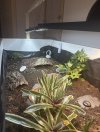 IMG_2024.jpeg275.7 KB · Views: 0
IMG_2024.jpeg275.7 KB · Views: 0 -
 IMG_2025.jpeg187.3 KB · Views: 0
IMG_2025.jpeg187.3 KB · Views: 0 -
 IMG_1675.jpeg104.4 KB · Views: 0
IMG_1675.jpeg104.4 KB · Views: 0 -
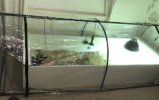 IMG_1674.jpeg60.6 KB · Views: 0
IMG_1674.jpeg60.6 KB · Views: 0 -
 IMG_1628.png178.4 KB · Views: 0
IMG_1628.png178.4 KB · Views: 0 -
 IMG_1669.png149.5 KB · Views: 0
IMG_1669.png149.5 KB · Views: 0 -
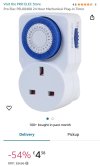 IMG_1985.jpeg116 KB · Views: 0
IMG_1985.jpeg116 KB · Views: 0 -
 IMG_2035.jpeg32.8 KB · Views: 0
IMG_2035.jpeg32.8 KB · Views: 0 -
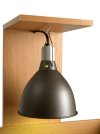 IMG_2029.jpeg66.7 KB · Views: 0
IMG_2029.jpeg66.7 KB · Views: 0 -
 IMG_2028.jpeg10 KB · Views: 0
IMG_2028.jpeg10 KB · Views: 0 -
 IMG_1684.jpeg147 KB · Views: 0
IMG_1684.jpeg147 KB · Views: 0 -
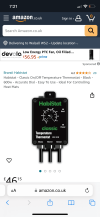 IMG_1679.png143.4 KB · Views: 0
IMG_1679.png143.4 KB · Views: 0 -
 IMG_1683.png151.5 KB · Views: 0
IMG_1683.png151.5 KB · Views: 0 -
 IMG_1733.jpeg29.9 KB · Views: 0
IMG_1733.jpeg29.9 KB · Views: 0 -
 IMG_1670.jpeg65.1 KB · Views: 0
IMG_1670.jpeg65.1 KB · Views: 0 -
 IMG_1672.jpeg84.7 KB · Views: 0
IMG_1672.jpeg84.7 KB · Views: 0 -
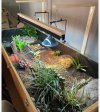 IMG_1871.jpeg238 KB · Views: 0
IMG_1871.jpeg238 KB · Views: 0 -
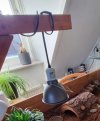 IMG_1872.jpeg48.1 KB · Views: 0
IMG_1872.jpeg48.1 KB · Views: 0 -
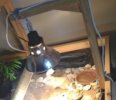 IMG_1873.jpeg32 KB · Views: 0
IMG_1873.jpeg32 KB · Views: 0 -
 IMG_2037.jpeg178.4 KB · Views: 0
IMG_2037.jpeg178.4 KB · Views: 0
Littleredfootbigredheart
Well-Known Member
These are some greens to feed(bear in mind the lettuce isn’t the most nutritional but fine to add as part of a varied diet);
Lambs lettuce
Romaine
Red leaf lettuce
Frisèe lettuce
Endive(chicory)
Spring greens
Kale
Rocket
Cress on occasion
The odd Brussel sprout on occasion
There’s also plenty of different weeds you can add! Providing you’re sourcing them from an area that is free of any harmful chemicals like pesticides and fertiliser, so be WARY! There’s lots of lookalikes that can be toxic, it might be best to grow your own from seeds online. We add dandelions and broadleaf plantain, I’ll add a link below you might find useful to look through🙂
Now let’s talk fruit! We remove any pips/seed/stones that are either toxic or a chocking hazard, so for my list, we’d remove the mango stone, plum stone, peach stone, nectarine stone, cherry stones(chocking hazard!), apricot stones, appel&pear seeds(toxic)
Ones we feed more regularly(but rotate cause variety is key):
Mango
Papaya
Pineapple
Raspberries
Melon
Strawberries
Watermelon(not super nutritional but a good hydration boost)
Plum
Peach
Nectarines
Cherries
Apricot
Blueberries
Figs
Guava
Prickly pear
Ones we feel less regularly:
Appel
Banana
Blackberries
Grapes
Pear
Those last ones are more of a treat basis. You can also try cherry tomatoes on occasion but not often.
We also sometimes grate a bit of carrot on our red foots food(not a lot) or some courgette, you can also add bell peppers on occasion, and they’ll also enjoy some mushroom once a week or so!
Hope this helps give you some ideas for variety🙂 we try not to give ours too much of just the one type of fruit in any given week, however she gets papaya pretty much daily, it makes up a large majority of their diet in the wild so definitely get your hands on some!
Also they’ll need some protein every 7-10 days, we personally give ours a head sized protein of steamed chicken breast, or a mouse we defrost from the reptile shop.
Calcium power can be added on 3 feeds a week.
Hope all this helps, any further questions, please ask😊
Lambs lettuce
Romaine
Red leaf lettuce
Frisèe lettuce
Endive(chicory)
Spring greens
Kale
Rocket
Cress on occasion
The odd Brussel sprout on occasion
There’s also plenty of different weeds you can add! Providing you’re sourcing them from an area that is free of any harmful chemicals like pesticides and fertiliser, so be WARY! There’s lots of lookalikes that can be toxic, it might be best to grow your own from seeds online. We add dandelions and broadleaf plantain, I’ll add a link below you might find useful to look through🙂
The Tortoise Table - Home
The Tortoise Table plant database and resource site for Tortoise owners
www.thetortoisetable.org.uk
Now let’s talk fruit! We remove any pips/seed/stones that are either toxic or a chocking hazard, so for my list, we’d remove the mango stone, plum stone, peach stone, nectarine stone, cherry stones(chocking hazard!), apricot stones, appel&pear seeds(toxic)
Ones we feed more regularly(but rotate cause variety is key):
Mango
Papaya
Pineapple
Raspberries
Melon
Strawberries
Watermelon(not super nutritional but a good hydration boost)
Plum
Peach
Nectarines
Cherries
Apricot
Blueberries
Figs
Guava
Prickly pear
Ones we feel less regularly:
Appel
Banana
Blackberries
Grapes
Pear
Those last ones are more of a treat basis. You can also try cherry tomatoes on occasion but not often.
We also sometimes grate a bit of carrot on our red foots food(not a lot) or some courgette, you can also add bell peppers on occasion, and they’ll also enjoy some mushroom once a week or so!
Hope this helps give you some ideas for variety🙂 we try not to give ours too much of just the one type of fruit in any given week, however she gets papaya pretty much daily, it makes up a large majority of their diet in the wild so definitely get your hands on some!
Also they’ll need some protein every 7-10 days, we personally give ours a head sized protein of steamed chicken breast, or a mouse we defrost from the reptile shop.
Calcium power can be added on 3 feeds a week.
Hope all this helps, any further questions, please ask😊

